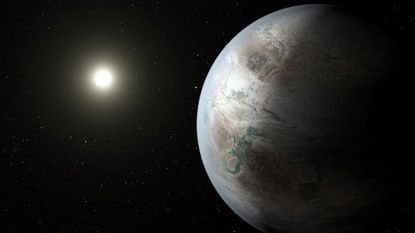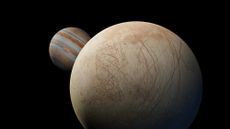Earth 2.0: could life exist on newly discovered planet?
Astronomers have found a large planet, Kepler-452b, which they say is 'the closest twin to Earth'

Scientists have discovered the most Earth-like planet yet seen, boosting their hopes of finding extraterrestrial life.
Researchers from Nasa, the Seti Institute and several universities made the discovery using data provided by the Kepler space telescope.
The new planet, dubbed Kepler-452b, is "the closest twin to Earth, or the Earth 2.0, that we've found so far," said Nasa's John Grunsfeld.
Subscribe to The Week
Escape your echo chamber. Get the facts behind the news, plus analysis from multiple perspectives.

Sign up for The Week's Free Newsletters
From our morning news briefing to a weekly Good News Newsletter, get the best of The Week delivered directly to your inbox.
From our morning news briefing to a weekly Good News Newsletter, get the best of The Week delivered directly to your inbox.
How similar to Earth is it?
The planet is 1,400 light years away in the constellation Cygnus and research suggests that it is roughly five times larger than Earth. Kepler-452b orbits a large star similar to our Sun at an almost identical distance, completing its orbit in 385 days.
This distance means surface temperatures on the planet would be suitable for water, a critical condition for life. "It would feel a lot like home, from the standpoint of the sunshine that you would experience," lead researcher Jon Jenkins told Space.com
What is the significance of the discovery?
Due to these conditions, Kepler-452b has a "substantial opportunity" to host life, says Nasa. Scientists predict that if plants were transferred there, they would probably survive.
"We're trying to answer really fundamental questions," Grunsfeld said. "Where are we going as human beings, and of course the really grand question: are we alone in the universe?"
As the planet's host star is 1.5bn year's older than the sun, scientists believe Kepler-452b could also point to a possible future for the earth, the BBC reports.
"The increasing energy from its aging sun might be heating the surface and evaporating any oceans. The water vapour would be lost from the planet forever," explained Dr Doug Caldwell, a scientist involved in the mission.
"Kepler-452b could be experiencing now what the Earth will undergo more than a billion years from now, as the Sun ages and grows brighter."
Create an account with the same email registered to your subscription to unlock access.
Sign up for Today's Best Articles in your inbox
A free daily email with the biggest news stories of the day – and the best features from TheWeek.com
-
 Is the Gaza war tearing U.S. campuses apart?
Is the Gaza war tearing U.S. campuses apart?Today's Big Question Protests at Columbia University, other institutions, pit free speech against student safety
By Joel Mathis, The Week US Published
-
 DOJ settles with Nassar victims for $138M
DOJ settles with Nassar victims for $138MSpeed Read The settlement includes 139 sexual abuse victims of the former USA Gymnastics doctor
By Justin Klawans, The Week US Published
-
 14 recent scientific breakthroughs
14 recent scientific breakthroughsIn Depth From photos of the infant universe to an energy advancement that could save the planet
By Devika Rao, The Week US Published
-
 14 recent scientific breakthroughs
14 recent scientific breakthroughsIn Depth From photos of the infant universe to an energy advancement that could save the planet
By Devika Rao, The Week US Published
-
 The hunt for Planet Nine
The hunt for Planet NineUnder The Radar Researchers seeking the elusive Earth-like planet beyond Neptune are narrowing down their search
By Chas Newkey-Burden, The Week UK Published
-
 Winchcombe meteorite: space rock may reveal how water came to Earth
Winchcombe meteorite: space rock may reveal how water came to EarthThe Explainer New analysis of its violent journey confirms scientific theories on the origin of our planet's H2O
By Sorcha Bradley, The Week UK Published
-
 Why the Moon is getting a new time zone
Why the Moon is getting a new time zoneThe Explainer The creation of 'coordinated lunar time' is part of Nasa's mission to establish a long-term presence on Earth's only natural satellite
By Richard Windsor, The Week UK Published
-
 We're in the golden age of space exploration
We're in the golden age of space explorationIn depth To infinity and beyond!
By Devika Rao, The Week US Published
-
 All the major moon landings so far
All the major moon landings so farThe Explainer One giant leap for mankind
By Devika Rao, The Week US Published
-
 Jupiter's Europa has less oxygen than hoped
Jupiter's Europa has less oxygen than hopedspeed read Scientists say this makes it less likely that Jupiter's moon harbors life
By Peter Weber, The Week US Published
-
 'Magnolias in space': why scientists have created the world's first wooden satellite
'Magnolias in space': why scientists have created the world's first wooden satelliteUnder The Radar New Japanese probe could help tackle 'graveyard of space junk' encircling Earth
By Chas Newkey-Burden, The Week UK Published